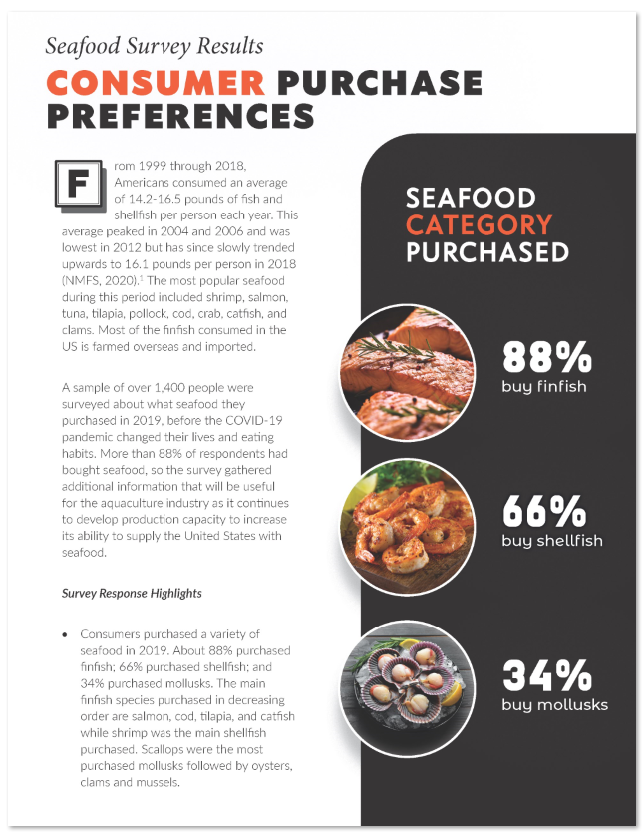
File Size: 5.14 MB
This is an annual summary of Illinois-Indiana Sea Grant success stories.
Flip through the magazine: https://issuu.com/iiseagrant/docs/thehelm-2021

This is an annual summary of Illinois-Indiana Sea Grant success stories.
Flip through the magazine: https://issuu.com/iiseagrant/docs/thehelm-2021

This brochure describes aquaculture basics and the benefits of eating locally produced fish. This product can be used as a consumer-facing resource to educate communities on sustainable aquaculture in the North Central Region of the United States.
A printer friendly version is available at: https://iiseagrant.org/wp-content/uploads/2020/06/EMWF2-7.pdf

This document provides results of a 2019 national consumer survey of seafood preferences carried out by Illinois-Indiana Sea Grant, Purdue University, Michigan State University, and Southern Illinois University.

This toolkit is a curated collection of information and resources focused on seafood for educators interested in supplementing existing programs. Topics covered in this publication include the health benefits of eating seafood, recommendations for including seafood as part of healthy eating patterns, sourcing, and seafood safety. In addition to information about nutrition and safety, there are sections on cooking methods, recipes, and social media that can be used for planning your next cooking demonstration and educating and inspiring clients.

This is the fourth in a series of consumer guides that describe fish and shellfish farmed in the Midwest region of the United States. (See Walleye Farmed Fish Fact Sheet, Yellow Perch Farmed Fish Fact Sheet, and Tilapia Farmed Fish Fact Sheet). The fact sheet also includes culinary characteristics, cooking tips, and a recipe for Grilled Rainbow Trout with Apricot Salsa.

Structural changes in Midwest agriculture over the past two decades have resulted in a number of empty and unused farm buildings. Farmers therefore have been exploring alternative uses of livestock farm buildings for the production of other cash crops, including aquaculture products. In Indiana, Pacific White shrimp (Litopenaeus vannamei) production has attracted interest, and a number of small producers are investing in shrimp produc- tion in their farm buildings and other farm facilities. The producers are motivated by the fact that they could produce and market fresh (never frozen) high-quality shrimp products in these systems to compete with imported frozen shrimp.

The hybrid striped bass (HSB) industry is the 4th largest aquaculture industry in the United States in terms of sales value, behind catfish, salmon, and trout. HSB is a cross between a female white bass (Morone chrysops) and a male striped bass (Morone saxatilis). HSB is also known as “”sunshine bass.”” The hybridization of the white bass and the striped bass makes HSB more tolerant to extreme temperatures and dissolved oxygen than either of its parents. There is potential for growth in production in Indiana and the Midwest because of the abundance of farm ponds and private lakes.

This is the fifth in a series of consumer guides that describe fish and shellfish farmed in the Midwest region of the United States. (See Walleye Farmed Fish Fact Sheet, Yellow Perch Farmed Fish Fact Sheet, and Tilapia Farmed Fish Fact Sheet). The fact sheet also includes culinary characteristics, cooking tips, and a recipe for Sautéed Old Bay® Shrimp
‡Note: Old Bay Seasoning is a registered trademark of McCormick & Company.

This is the ninth in a series of consumer guides that describe fish and shellfish farmed in the Midwest region of the United States. (See Atlantic Salmon Farmed Fish Fact Sheet, Walleye Farmed Fish Fact Sheet, Yellow Perch Farmed Fish Fact Sheet, Tilapia Farmed Fish Fact Sheet, Rainbow Trout Farmed Fished Fact Sheet, Pacific White Shrimp Farmed Fish Fact Sheet, American Paddlefish Farmed Fish Fact Sheet, and Channel Catfish Farmed Fish Fact Sheet). The fact sheet also includes culinary characteristics, cooking tips and a recipe for Pan Fried Largemouth Bass with Garlic Herb Sauce.